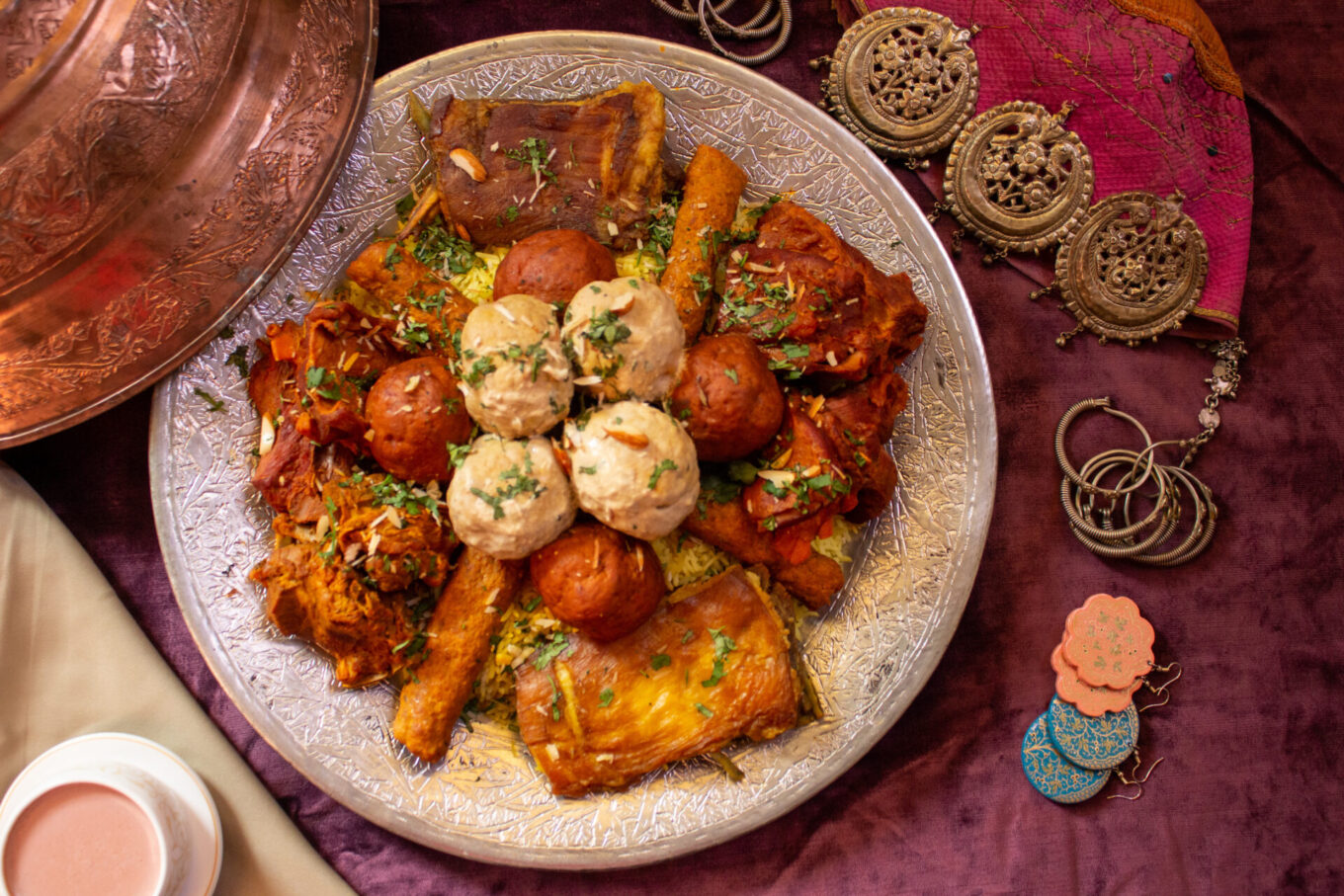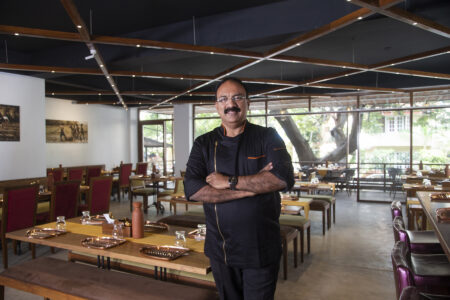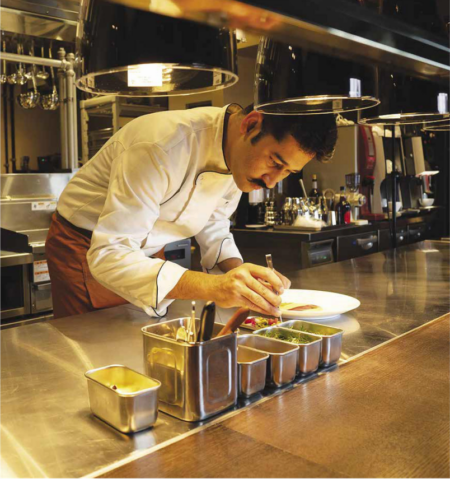The moment the copper cloche that covers your food on a traami is raised, a story of place and people begins to unfold. The beautifully crafted cloche, ‘sarposh’, has a practical use: to keep food warm in the cold temperatures of Kashmir. Azmat Ali Mir chose to name the Kashmiri restaurant she opened in Bengaluru Sarposh, after this emblematic, dome-shaped cover. When she consulted Zareef Ahmed, ‘a noted Kashmiri historian and poet, he wasn’t convinced of the choice,’ says Azmat, ‘because the word held other nuances of meaning.’ ‘Sarposh’, she elaborates, ‘is also a metaphor for concealing something, or keeping a secret’.
For Azmat, though, it conveyed precisely what she wanted—when the cloche is lifted, Kashmiri cuisine and layer after layer of stories of her heritage, stories often distorted by decades of geo-politics, violence and misunderstanding are revealed through the food on the table.
Azmat chose boldly: up a flight of unprepossessing steps, inside a room that references fourteen craft traditions of Kashmir in its décor, an introduction to her heritage comes through the dishes of the famed wazwan, which she terms ‘the zenith of Kashmiri hospitality’. Sarposh uses the wazwan, an elaborate, meat-centric feast cooked by a dedicated community of professional chefs who have carried the secrets of this sub-cuisine for generations as a framework of reference for the cuisine of Kashmir, with its rich inflections of an inheritance drawn from a unique geographical position, complex history and location on the Silk Route.
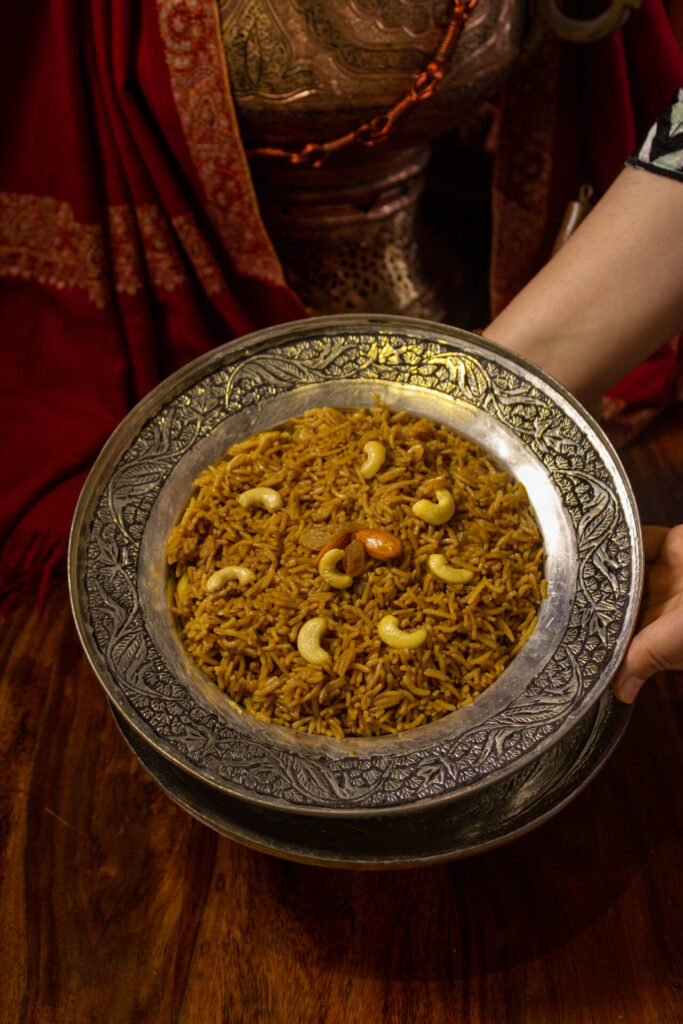
A mound of rice is served on a tinned copper platter, traami, traditionally 16 inches in diameter so that each diner has their own quarter of dining space. It’s an egalitarian, community feast eaten seated on the floor. The four people who sit down to share a platter may be from very different social backgrounds, may not even have met before sitting down to share the meal, emphasizing the idea that food, as a shared social experience can—and does—cross barriers. This is a feast that speaks a language all its own, crafted by chefs who come from one of the most picturesque and remote parts of Kashmir, a typically lavish meal, sometimes stretching to seventy-two dishes. Of these, says Azmat, 7 are essential; tender seekh kababs wrapped around a skewer and grilled, the famed tabak maaz (twice-cooked lamb ribs, fatty and flavourful), methi maaz (lamb innards with fenugreek), are served on rice, and may be followed by dani phol (lamb shanks), wazae kokur (waza’s chicken) and shaemi kabab, amongst other choices. Rista, rogan josh and several other options including vegetarian dishes lead to marchewangan kormae (mutton korma) and gushtabae yakhin that signal the end of the meal. Beyond wedding feasts, wazwans feature on all life’s special occasions from births, funerals and religious functions, to every kind of event that needs to be marked as out of the ordinary. Our hands washed into a tash naer (an etched copper ewer and basin), sitting before a platter of these delicacies served on fragrant heaps of rice cooked by the team of professional wazas from Kashmir who run the Sarposh kitchen, it’s hard to imagine that this unique restaurant had its beginnings in a WhatsApp group started by a young Kashmiri woman yearning for home, trying to hold onto her culture by whatever means she had on hand.
An engineer by training, Azmat is an energetic, fine-looking woman, who becomes animated when she begins to speak of what her traditions mean to her. Married into a non-Kashmiri family, she shifted base to Bengaluru in 2018 triggering a sudden and acute sense of cultural dislocation: the nuances of her culture were incomprehensible to the people around her, the people who mattered most, made most apparent in their perceptions of Kashmiri food. The prized mushk budij rice, fragrant, rare and expensive, served to welcome the bridegroom’s family was viewed with disregard as just another short-grained rice, not worthy of the occasion. The meat dishes of the wazwan, epitome of Kashmiri hospitality, were considered overwhelming by her new family. ‘This rejection of my food was deeply upsetting. I found myself wanting to hold onto details, wanting to belong to that particular place which was home. I wanted to speak my language with someone, and hear it being spoken”. We sip on fragrant kahwa, delicately spiced, golden with Kashmiri saffron, the best in the world, as she describes the WhatsApp group she set up which had over 200 displaced Kashmiris join within an hour, and eventually brought together over 1000 people at a gathering in Bengaluru. The spark of the idea of sharing her culture with a wider circle through food was animated here.
Growing up at the peak of the violence and uncertainty in Kashmir, Azmat nevertheless made joyful memories with her family, many of them built around food. “Kashmir is frequently viewed through the extremes of jannat and jahannan, but there is a whole world in between, a world of people”, she recalls, “where we just lived our everyday lives. Family picnics were frequent and impromptu, despite the risk and uncertainty of returning home after dark. Military check-points were inescapable, and the vocabulary of violent conflict coloured our everyday language. But meeting over food was an important part of our lives, it became a focal point to bring some normalcy to the times we were living through.”
Food was the path she chose to find her way back to this world, to reclaim her identity, retrieve memories, hold onto experiences in the hope of passing them onto the next generation.
Over the next couple of years, setbacks dogged her plans for a restaurant, which lurched through some of the most cataclysmic events of our times: from the snapping of communication services in Kashmir, to investors pulling out fearing instability, to the pandemic lockdown, and putting personal money into the business, the idea of Sarposh survived, ready to welcome guests by the end of 2020.
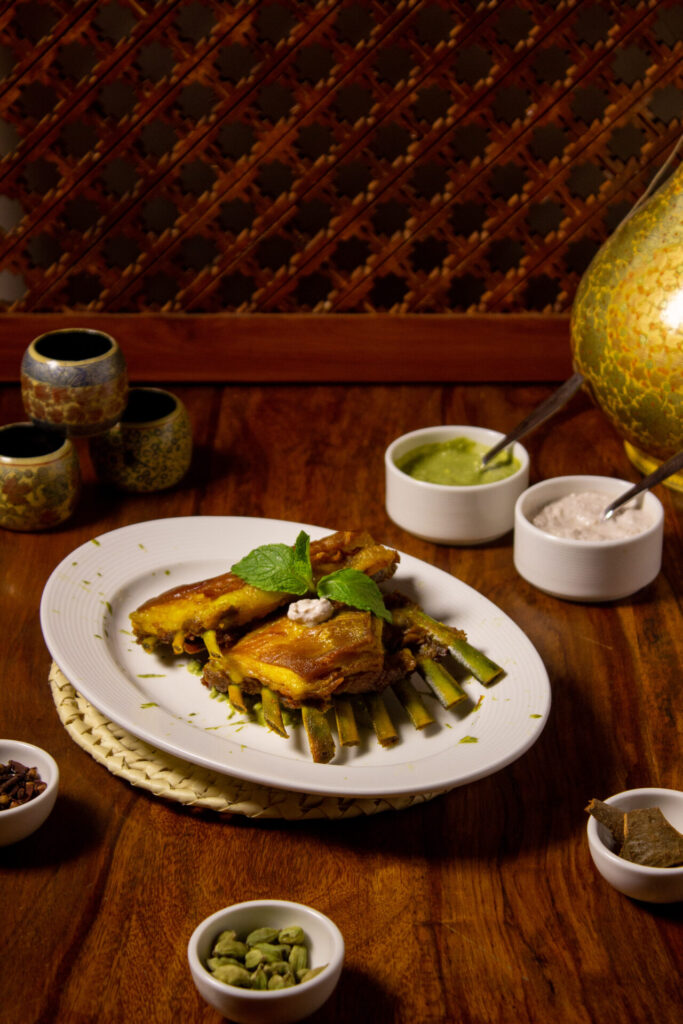
As a Kashmiri restaurateur, Azmat has carved out a unique space for herself. She has breached the all-male bastion of the wazwan, where not only is all the cooking done by men, but even the interface at an event is between the wazas and senior male members of the family. “The only role that the women have is in the cleaning of the greens, garlic and praan—they sing and dance while doing this, but their responsibilities are limited”, says Azmat, smiling widely. “Women do not join in these feasts, although there is no other segregation.” It takes some imagination to guess at the challenges she has overcome to gain a firm grip on the workings of wazwan, including the mathematical precision with which meat is used in the preparation of dishes. “The meat has to be absolutely fresh, there can be no compromise. Every dish is worked out of a specific part of the lamb—apart from head and trotters, everything is used. The hind legs go into pounded meatballs (rista, gushtaba); shanks into dani phol; back into rogan josh; ribs make tabak maas; flanks of ribs into mirchi quorma; shoulder into aab gosht, finally, the front legs into lamb shanks. A lamb gives you 5 tram, each with 4 gushtaba; 4 rista; 4 rogan josh; 4 mirchi quorma; you fall short on tabak maaz, but still get aab gosht. This covers the basic 7 dishes and an extra one or two, so twenty people can eat from a single lamb.”
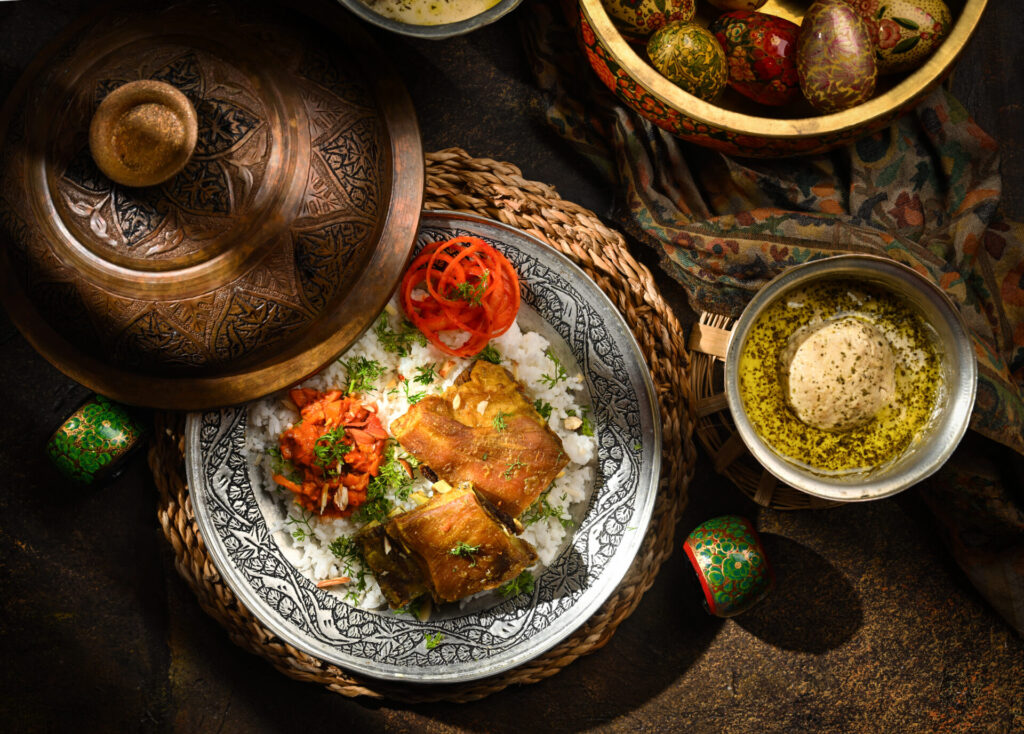 At Sarposh, the extensive menu changes frequently with new items being added every season, including a lot of home-style preparations. Apart from the 7 basic dishes, there are least thirty wazwan dishes available and some special vegetarian dishes such as tamatar paneer (piquant tomatoes and a large slab of paneer in a minty gravy), wazae palak (spinach, traditionally cooked with tiny rista balls, but made vegetarian), wazae dum oulv (a curd-based dish), wazae heddar (mushrooms in a curd base), razmah (red kidney beans) and ale yakhin (bottle gourd yakhni) that showcase the largely unsung excellence of the Kashmiri use of seasonal and dried vegetables. This breath-taking sweep of culinary heritage is presented by a team of professional wazas from Kashmir that manages the Sarposh kitchen.
At Sarposh, the extensive menu changes frequently with new items being added every season, including a lot of home-style preparations. Apart from the 7 basic dishes, there are least thirty wazwan dishes available and some special vegetarian dishes such as tamatar paneer (piquant tomatoes and a large slab of paneer in a minty gravy), wazae palak (spinach, traditionally cooked with tiny rista balls, but made vegetarian), wazae dum oulv (a curd-based dish), wazae heddar (mushrooms in a curd base), razmah (red kidney beans) and ale yakhin (bottle gourd yakhni) that showcase the largely unsung excellence of the Kashmiri use of seasonal and dried vegetables. This breath-taking sweep of culinary heritage is presented by a team of professional wazas from Kashmir that manages the Sarposh kitchen.
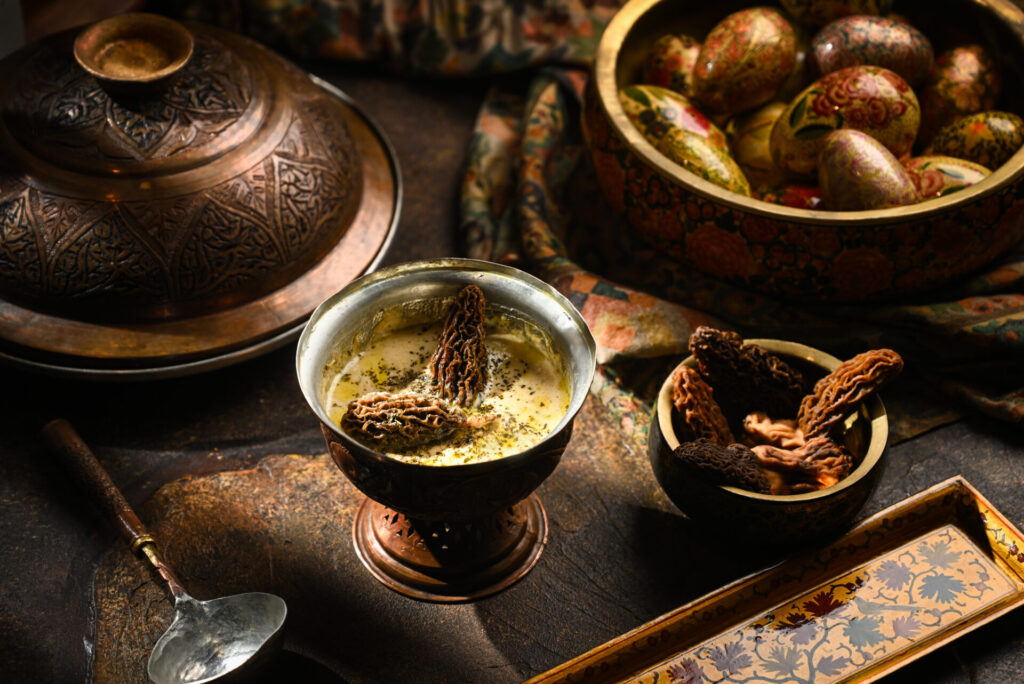 “The wazas, explains Azmat, “are generally from the Sheena-speaking Dardic belt of the Gurez region. Many have migrated and now live in Ganderbal, on the outskirts of Srinagar, or in Waza Pora, in the heart of the city. It’s essentially a hereditary profession, but takes years of work and practice to become a Head wosta or Head chef.” The carving of the meat and managing the cooking on a woodfire is done by the most experienced team members. Young apprentices are set to peeling praan (shallots) or pounding walnuts. The more skilled hands sit down to pounding the meat which passes through three stages during the pounding process. Again, roles are ascribed based on experience and skill. Food is cooked in traditional heavy-bottomed, narrow-necked, wide copper vessels called degs or degchewari, placed directly on a wood fire fuelled by wood from fruit trees. The wazas use a range of specialized implements including the pounding stone (kaeyn); wooden mallets for pounding (goshpor); wooden butcher’s block (paetr); a large stone mortar (nyaem) and a wooden pestle (tchote); speciality knives and large wooden and copper spoons (choncha).
“The wazas, explains Azmat, “are generally from the Sheena-speaking Dardic belt of the Gurez region. Many have migrated and now live in Ganderbal, on the outskirts of Srinagar, or in Waza Pora, in the heart of the city. It’s essentially a hereditary profession, but takes years of work and practice to become a Head wosta or Head chef.” The carving of the meat and managing the cooking on a woodfire is done by the most experienced team members. Young apprentices are set to peeling praan (shallots) or pounding walnuts. The more skilled hands sit down to pounding the meat which passes through three stages during the pounding process. Again, roles are ascribed based on experience and skill. Food is cooked in traditional heavy-bottomed, narrow-necked, wide copper vessels called degs or degchewari, placed directly on a wood fire fuelled by wood from fruit trees. The wazas use a range of specialized implements including the pounding stone (kaeyn); wooden mallets for pounding (goshpor); wooden butcher’s block (paetr); a large stone mortar (nyaem) and a wooden pestle (tchote); speciality knives and large wooden and copper spoons (choncha).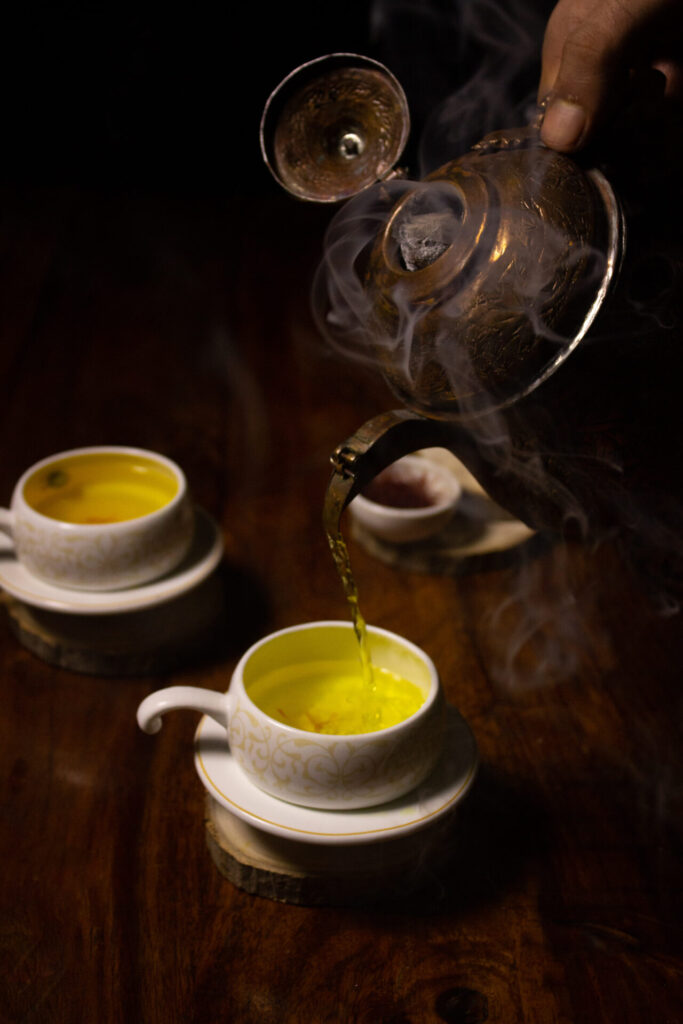 In her pursuit to bring out the true flavours of the dishes and a sense of the seasons from which they emerge, Azmat sources terroir specific ingredients from Kashmir. One essential element that forms the base of many gravies is praan, strong smelling Kashmiri shallots that have a very short season. Praan is chopped and fried in desi ghee and stored for use, giving a pungency to a dish rather than the sweetness of onions. Ver masala, the distinctive spice blend dry ground, kneaded and worked into a pliable paste with mustard oil, matured and dried, is a complex mixture of various aromatic spices, Kashmiri red chillies, praan (in Muslim kitchens, mountain garlic) another important element, used in assorted ways. Zeera (cumin seeds) are sourced from Gurez and Drass, both varieties very aromatic and flavourful.
In her pursuit to bring out the true flavours of the dishes and a sense of the seasons from which they emerge, Azmat sources terroir specific ingredients from Kashmir. One essential element that forms the base of many gravies is praan, strong smelling Kashmiri shallots that have a very short season. Praan is chopped and fried in desi ghee and stored for use, giving a pungency to a dish rather than the sweetness of onions. Ver masala, the distinctive spice blend dry ground, kneaded and worked into a pliable paste with mustard oil, matured and dried, is a complex mixture of various aromatic spices, Kashmiri red chillies, praan (in Muslim kitchens, mountain garlic) another important element, used in assorted ways. Zeera (cumin seeds) are sourced from Gurez and Drass, both varieties very aromatic and flavourful.
The search for the right ingredients was instructive: “I found that the famed Kashmiri red chilli was being substituted with chillies grown from the seeds of the Bayadgi, from North Karnataka,” says Azmat. A visit to the Horticultural Department for the right seeds, a few experiments in their kitchen garden, and visits to Pulwama, where the best chillies grow, resulted in rich rewards. Not only does Sarposh have a source for the original chillies grown in kitchen gardens by women, there is now a collective of over 500 farmers who also grow saag (leafy greens), pumpkins and local vegetables, feeding the Sarposh table. “Everyone in Kashmir has a small garden or a few walnut and almond trees”, observes Azmat, “and we benefit from this. We are happy to source from our staff. One manager is from Pampore which grows the best saffron, and we source from his farm. This year, I was there to harvest the saffron myself.” Even the dried mint is grown in her family’s kitchen garden, dried and hand-powdered by an old member of staff. Even though standard dry spices are widely available, she favours the Kashmiri brands that manufacture specifically for wazwans. “The staff,’ she stresses, “are deeply involved in maintaining quality, and some days they reject produce which drops even slightly below our standards. This would never be possible in a typical commercial kitchen.”
An evocation of the daily rhythms of Kashmiri life comes through in something as simple, yet inseparable from the memories of ordinary days as bread. A wide, coal-fired clay oven was built to bake the sourdough breads which are a focal point of the social life of Kashmiris. Breads, which are occasion specific, are usually eaten with tea or with barbecued street foods, rather than main meals. The kandur waan, traditional bakehouse found in every locality making kandur tchot (bread made by the kandur, or baker) is so intricately woven into the fabric of Kashmiri life, it speaks a language entirely its own. A clay oven was specially constructed at Sarposh for breads such as girda tchot and lavasa, usually baked at dawn, picked up on the way back from morning prayers and eaten with nun chai (salted pink tea) or regular tea. An entire layer of life swirls around the pause for bread, where news and gossip are exchanged, politics discussed and friendships re-affirmed. “Since the breads are all made with sourdough, we have brought our culture from Kashmir, a culture that has been running for over two hundred years. We serve the entire range of kandur breads every day: girda, lavasa and bakirkhani; we make tchochowor, an evening bread (a small Bagel shaped crusty bread topped with sesame seeds) and kulcha on order, as these require to be prepared in bulk. The sheermal comes from Kashmir, from a specific kandur shop that makes it the best.”
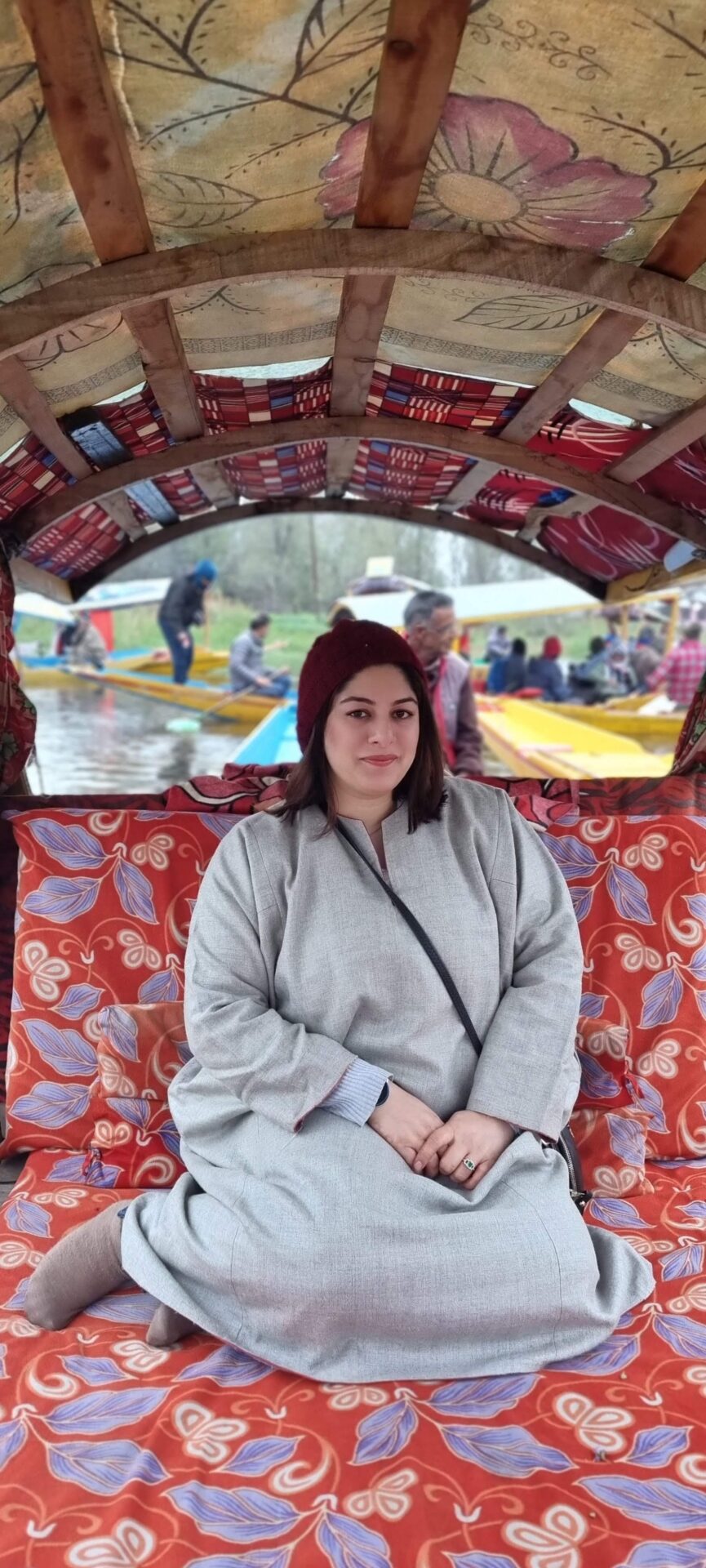 Two years on, Azmat, speaks of the creation of Sarposh as “an expression of who I am and where I come from; an expression of my identity, an extension of my home.” In the process of bringing something of her Kashmiri heritage to the table, there are also the vivid portraits of the hands that farm, grow, cook, bake, the people who stop by the kandur to collect their daily bread and discuss, over a cup of nun chai, all the layered complexities of their everyday lives. Lives that might otherwise remain incomprehensible to many of us.
Two years on, Azmat, speaks of the creation of Sarposh as “an expression of who I am and where I come from; an expression of my identity, an extension of my home.” In the process of bringing something of her Kashmiri heritage to the table, there are also the vivid portraits of the hands that farm, grow, cook, bake, the people who stop by the kandur to collect their daily bread and discuss, over a cup of nun chai, all the layered complexities of their everyday lives. Lives that might otherwise remain incomprehensible to many of us.
This article has appeared in Uppercrust Magazine.

